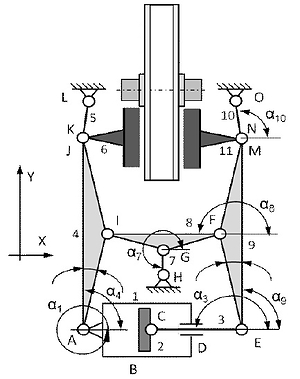Vibrations and noise generated by rail vehicle disc brake
1
Politechnika Poznańska
Publication date: 2021-06-10
Rail Vehicles/Pojazdy Szynowe 2016,3,56-62
ABSTRACT
The noise generated by motor vehicles is one of the
negative factors affecting the deterioration of the environment
(especially acoustic), where people are present.
Vibroacoustic phenomena, especially those emitted
by braking systems, are regarded as highly undesirable.
The problem of vibration in the brakes, in both
rail and road vehicles, was already noticed in the 30s
of the twentieth century [10]. At the beginning the
researchers pointed out that the noise and vibration
generated by the brake was due to the friction characteristics
of the tribological pair, making the appearance
of the effect was the result of the value of the friction
coefficient changing along with the rotational speed. It
was also claimed that the coefficient of static friction
is greater than kinetic friction. The consequence of
vibration in the brake in conjunction with the propagation
of sound is the unstable work of the brake system
manifested by a variable value of the instantaneous
friction coefficient.
Described problems are the result of research conducted
in the framework of a project funded by the
National Centre for Research and Development
(LIDER V program, No. LIDER/022/359/L-
5/13/NCBR/2014).
REFERENCES (12)
1.
Kaluba M., Zużycie okładzin ciernych hamulca tarczowego pojazdów szynowych, Pojazdy Szynowe 1999 nr 4, s. 24-29.
2.
Kądziołka T., Kowalski S, Smolarski D., Analiza porównawcza wrażliwości dźwigniowych hamulców kolejowych, Pojazdy szynowe nr 1/2011.
3.
Kinkaid N.M., O’Reilly O. M, Papadopoulos P., Automotive disc brake squeal. Journal of sound and vibration 267 (2003) 105-166. Department of Mechanical Engineering, University of California, Berkeley, USA.
4.
Nowicki J., Obliczenia symulacyjne skuteczności hamowania pociągu, XIV Konferencja Naukowa POJAZDY SZYNOWE 2000, Kraków, Arkanów, 9-13 październik 2000, t. 2, s. 139-146.
5.
North M.R, Disc brake squeal—a theoretical model, Technical Report 1972/5, Motor Industry Research Association, Warwickshire, England, 1972.
6.
Rudolph M., Popp K., Brake squeal, in: K. Popp (Ed.), Detection, Utilization and Avoidance of Nonlinear Dynamical Effects in Engineering Applications: Final Report of a Joint Research Project Sponsored by the German Federal Ministry of Education and Research, Shaker, Aachen, 2001, pp. 197–225.
7.
Rudolph M., Popp K., Friction induced brake vibrations, in: CD-ROM Proceedings of DETC’01, DETC2001/VIB-21509, ASME, Pittsburgh, PA, 2001, pp. 1–10.
8.
Sawczuk W., Szymański G. Zastosowanie testów impulsowych do oszacowania częstotliwości rezonansowych wybranych elementów kolejowego układu hamulcowego, Logistyka 6/2014.
10.
Ścieszka S.F., Hamulce cierne. Zagadnienia materiałowe, konstrukcyjne i tribologiczne, Wydawnictwo Gliwice-Radom 1998, s.15.
12.
Triches Junior M., Samir N. Y. Gerges, Jordan R., Analysis of brake squeal noise using finite element method: A parametric study, Federal University of Santa.
We process personal data collected when visiting the website. The function of obtaining information about users and their behavior is carried out by voluntarily entered information in forms and saving cookies in end devices. Data, including cookies, are used to provide services, improve the user experience and to analyze the traffic in accordance with the Privacy policy. Data are also collected and processed by Google Analytics tool (more).
You can change cookies settings in your browser. Restricted use of cookies in the browser configuration may affect some functionalities of the website.
You can change cookies settings in your browser. Restricted use of cookies in the browser configuration may affect some functionalities of the website.



